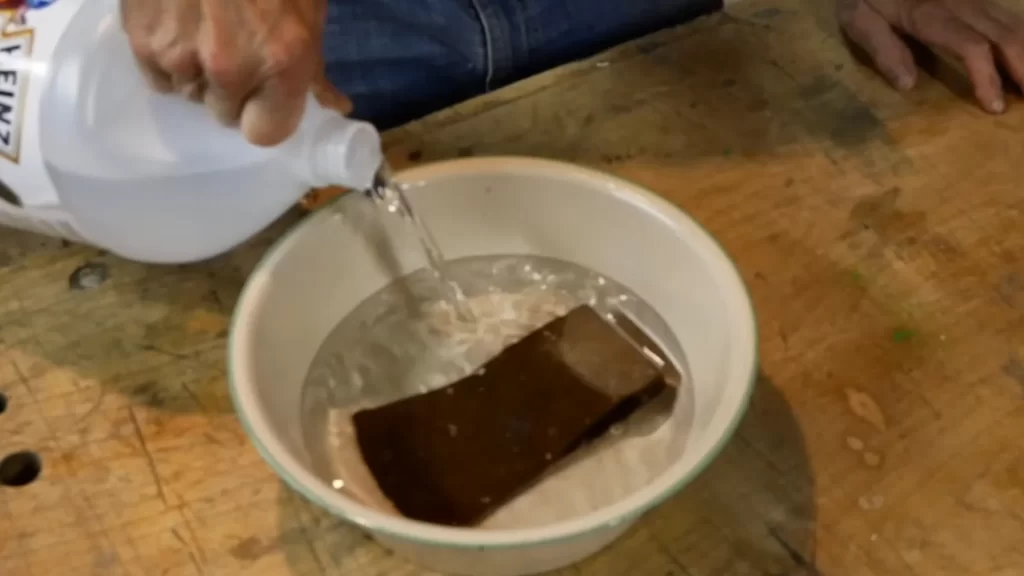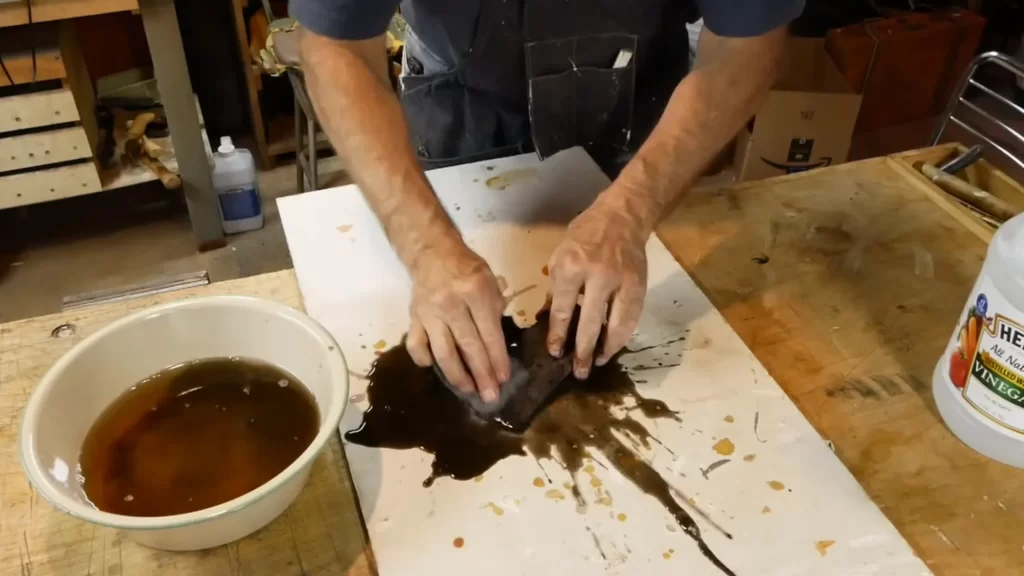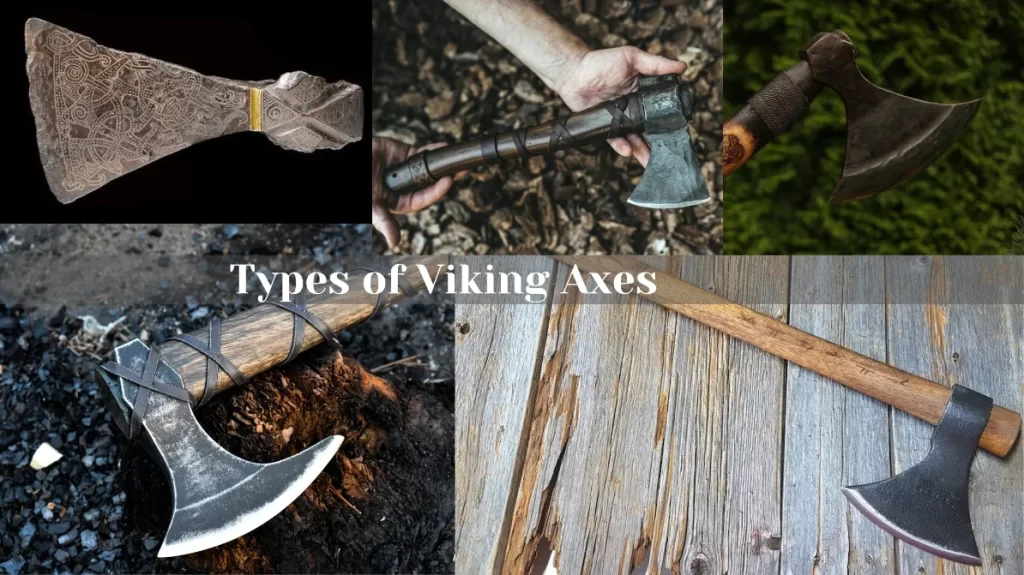Rust is a common problem for metal tools, especially with iron and steel, and axe heads are no exception. Rust can cause the axe head to become pitted and corroded, and create holes or cracks, which can make it less effective and more dangerous to use. The axe will also lose its sharpness and strength because of rust, making it harder and more dangerous to use.
Rust will not only make your tool look dull and dirty, but also affects its performance and durability. That’s why it’s important to know how to remove rust from axe head and prevent it from forming in the first place.

Contents
Understanding the Causes and Effects of Rust on Axe Head
Rust can form on axe heads for a number of reasons. One common cause is exposure to moisture. Rust is a chemical reaction that occurs when iron or steel (the main components of most metal tools) comes into contact with oxygen and moisture. The oxygen and moisture react with the iron atoms and form iron oxide, which is the reddish-brown substance that we call rust.
Rust can form on your axe head due to various factors, such as exposure to rain, snow, humidity, salt, or acidic substances. In addition, rust can also form if you store your axe in a damp or poorly ventilated place, or if you don’t clean and dry your axe properly after use.

Methods for Removing Rust from Axe Head
When it comes to restoring the lustre of your cherished axe, there’s a range of methods to remove rust from your old axe. Each method has its own unique approach to tackling rust, and the choice of which one to use depends on the severity of the rust and your personal preferences. Here are five tried-and-true methods to restore rusty axe head:
For every rust removing method, I recommend sharpening your axe head after proper cleaning and polishing.
Method 1: White Vinegar
One of the most common and effective methods for removing rust from axe head is using white vinegar. Vinegar is a natural rust remover that contains acetic acid, which dissolves the iron oxide and leaves behind the pure metal. Vinegar is also cheap, easy to find, and safe to use.
To use vinegar to remove rust from axe head, you will need the following materials:
- A large container or bucket
- White vinegar
- Water
- A brush or a sponge
- A cloth or a towel
- Gloves
- Some oil or axe wax
Here are the steps and tips for using vinegar to remove rust from axe head, (make sure to disassemble the axe head from the haft first):
1. Put on the gloves, fill the container or bucket with enough white vinegar to submerge the axe head completely. You can dilute the vinegar with some water if you want, but pure vinegar will work faster and better.
2. Place the axe head in the vinegar solution and let it soak for at least 24 hours. You can leave it longer if the rust is very stubborn or thick.

3. After soaking, take out the axe head and scrub the rust off with a brush or a sponge. You can also use steel wool or sandpaper for tougher spots, but be careful not to scratch the metal surface too much.

4. Rinse the axe head with clean water and dry it thoroughly with a cloth or a towel. You can also use a hair dryer to speed up the drying process and prevent any moisture from remaining on the axe head.

5. Apply some oil or wax to the axe head to protect it from future rusting and to give it a nice shine.
Pros:
- It is natural, cheap, and easy to find
- It is effective and fast
- It is safe and environmentally friendly
Cons:
- It has a strong and unpleasant smell
- It can be acidic and corrosive to the metal surface if left too long
- It can damage the wooden handle or other parts of the axe if they are exposed to the vinegar solution
Method 2: Baking Soda
Another method for removing rust from axe head is using baking soda. Baking soda is a mild abrasive and a base that neutralizes the acid in rust and loosens it from the metal surface.
Baking soda is also cheap, easy to find, and safe to use. To use baking soda to remove rust from axe head, you will need the following materials:
- A bowl or a cup
- Baking soda
- Water
- A brush or a sponge
- A cloth or a towel
Here are the steps and tips for using baking soda to remove rust from axe head:
1. In a bowl or a cup, mix some baking soda and water to form a thick paste. You can adjust the ratio of baking soda and water depending on how thick or thin you want the paste to be.
2. Apply the baking soda paste to the axe head and spread it evenly over the rusted areas. You can use a brush or a sponge to help you with this step.
3. Let the baking soda paste sit on the axe head for at least 15 minutes. You can leave it longer if the rust is very stubborn or thick.
4. After letting the baking soda paste sit, scrub the rust off with a brush or a sponge. You can also use steel wool or sandpaper for tougher spots, but be careful not to scratch the metal surface too much.
5. Rinse the axe head with clean water and dry it thoroughly with a cloth or a towel. You can also use a hair dryer or a heat gun to speed up the drying process and prevent any moisture from remaining on the axe head.
6. Apply some oil or wax to the axe head to protect it from future rusting and to give it a nice shine.
Pros:
- It is natural, cheap, and easy to find
- It is effective and gentle
- It is safe and environmentally friendly
Cons:
- It can be messy and sticky
- It can leave some residue or powder on the metal surface
- Baking soda can be slow to remove heavy rust
Method 3: Steel Wool
A third method for removing rust from axe head is using steel wool. Steel wool is a coarse abrasive that scrapes off the rust and polishes the metal surface. Steel wool is also relatively cheap, easy to find, and simple to use. To use steel wool to remove rust from axe head, you will need the following materials:
- Fine grade steel wool
- A cloth or a towel
- Gloves
- Oil or wax
Here are the steps and tips for using steel wool to remove rust from axe head:
1. Choose the right grade of steel wool for your axe head. The lower the number, the coarser the steel wool. For example, #0000 is the finest grade, while #4 is the coarsest grade. You can start with a coarser grade and work your way up to a finer grade, or you can use a medium grade throughout the process.
2. Put on the gloves and rub the steel wool on the axe head in a circular motion, applying some pressure and covering the rusted areas. You can also use some oil or wax to lubricate the steel wool and the axe head, which will make the process easier and smoother.
3. Wipe off the rust and the steel wool particles with a cloth or a towel. You can also rinse the axe head with clean water and dry it thoroughly with a cloth or a towel.
4. Repeat the process until you are satisfied with the results. You can also use a finer grade of steel wool to polish the axe head and give it a shiny finish.
5. Apply some oil or wax to the axe head to protect it from future rusting and to give it a nice shine.
Pros:
- It is effective and fast
- It is simple and straightforward
- It can also polish the metal surface
- Doesn’t require the use of chemicals
Cons:
- Steel wool can be dangerous to skin if you are not wearing gloves
- May not be suitable for heavy rust
- Requires some elbow grease
Method 4: Sandpaper
Sandpaper is a fine abrasive that smooths out the rust and the metal surface. Sandpaper is also relatively cheap, easy to find, and simple to use. To use sandpaper to remove rust from axe head, you will need the following materials:
- Sandpaper (various grits for different levels of rust)
- A cloth or a towel
- Gloves
- Oil or wax
Here are the steps and tips for using sandpaper to remove rust from axe head:
1. Choose the right grit of sandpaper for your axe head (coarser grit for heavy rust, finer grit for lighter rust). The lower the number, the coarser the sandpaper. For example, 60-grit is the coarsest grade, while 400-grit is the finest grade. You can start with a coarser grade and work your way up to a finer grade, or you can use a medium grade throughout the process. (I prefer different grit for different level of rust).
2. Sand the axe head in a circular motion, applying some pressure and covering the rusted areas. It is better to apply some oil to lubricate the axe head, which will make the process easier and smoother.
3. Wipe off the rust and the sandpaper particles with a cloth or a towel. You can also rinse the axe head with clean water and dry it thoroughly with a cloth or a towel. You can also use a hair dryer or a heat gun to speed up the drying process and prevent any moisture from remaining on the axe head.
4. Repeat the process until you are satisfied with the results. You can also use a finer grade of sandpaper to polish the axe head and give it a shiny finish.
5. Apply some oil or wax to the axe head to protect it from future rusting and to give it a nice shine.
Pros:
- It is effective and fast for various levels of rust
- It is simple and straightforward
- It can also polish the metal surface
Cons:
- It can scratch the metal surface and damage the wooden handle or other parts of the axe if they are exposed to the sandpaper
- Requires time and effort, especially for heavy rust
Method 5: Electrolysis
Electrolysis is a process that uses electricity to remove rust from metal. is also very effective, fast, and safe. However, it is also more complex, expensive, and requires more materials and equipment. To use electrolysis to remove rust from axe head, you will need the following materials:
- A plastic container or bucket
- Water
- Washing soda or baking soda
- A battery charger or a power supply
- A sacrificial anode, such as a piece of scrap metal or a steel rod
- Some wires and clips
- A cloth or a towel
- Oil or wax
Here are the steps and tips for using electrolysis to remove rust from axe head:
1. Fill the plastic container or bucket with enough water to submerge the axe head completely. Add some washing soda or baking soda to the water and stir well. This will create an electrolyte solution that will conduct electricity.
2. Connect the positive terminal of the battery charger or the power supply to the sacrificial anode using a wire and a clip. The sacrificial anode will act as the cathode in the electrolysis process and will attract the rust from the axe head.
3. Connect the negative terminal of the battery charger or the power supply to the axe head using another wire and a clip. The axe head will act as the anode in the electrolysis process and will release the rust into the electrolyte solution.
4. Place the sacrificial anode and the axe head in the electrolyte solution, making sure they are not touching each other or the sides of the container. Turn on the battery charger or the power supply and let the electrolysis run for a few hours or until the rust is completely removed from the axe head.
5. Turn off the battery charger or the power supply and disconnect the wires and clips. Take out the axe head and the sacrificial anode from the electrolyte solution and dispose of them properly. The sacrificial anode will be covered with rust and the electrolyte solution will be dirty and contaminated.
6. Rinse the axe head with clean water and dry it thoroughly with a cloth or a towel. You can also use a hair dryer or a heat gun to speed up the drying process and prevent any moisture from remaining on the axe head.
7. Apply some oil or wax to the axe head to protect it from future rusting and to give it a nice shine.
Video Tutorial to Remove Rust from Axe Head using Electrolysis
Pros:
- Electrolysis is a very effective way to remove rust, even from heavily rusted axe heads.
- It is safe and does not damage the metal surface or the wooden handle
- It does not require any scrubbing or polishing
Cons:
- It is more complex and expensive
- It requires more materials and equipment
- It produces waste and pollution
And if your axe has been sitting for a long while and the haft is loose, here’s a guide to fix loose axe handle.
Polishing and Protecting the Axe Head
After removing rust from axe head using any of the methods mentioned above, it’s better to polish the axe head to remove any remaining rust particles and achieve a smooth and shiny surface.
Polishing the axe head will also improve its appearance and performance, as well as prevent any future rusting.
There are different ways to polish the axe head, depending on the level of finish you want and the materials you have. Here are some of the most common ways to polish the axe head:
1. Polishing Compounds
Polishing compounds are substances that contain fine abrasives that can remove scratches, stains, and oxidation from the metal surface. They can also create a glossy or matte finish, depending on the type and amount of compound used.
To use polishing compounds, you will need a cloth or a rag, and some elbow grease. You can apply the polishing compound to the cloth or rag, and rub it on the axe head in a circular motion, covering the entire surface. You can also use a drill or a rotary tool with a polishing attachment to make the process easier and faster.
Repeat the process with different grades of polishing compounds, starting from the coarsest to the finest, until you achieve the desired finish. We recommend using some oil or wax to remove any residue or dust from the polishing compound, and to protect the axe head from future rusting.
2. Buffing Wheels
Buffing wheels are devices that spin at high speeds and create friction and heat on the metal surface, which can remove scratches, stains, and oxidation, and create a mirror-like finish. Buffing wheels can also be used with polishing compounds or wax to enhance the effect.
To use buffing wheels, you will need a buffing wheel, a drill or a rotary tool, and some polishing compound or wax. You can attach the buffing wheel to the drill or the rotary tool, and apply some polishing compound or wax to the buffing wheel. You can then press the buffing wheel against the axe head, moving it in a circular motion, covering the entire surface.
Since the rusted axe heads are often made with high carbon steel or iron, it is advised to repeat the process with different types of buffing wheels, such as cotton, sisal, or flannel, until you achieve the desired finish.
Preventive Measures Against Axe Head Rust
Once you have removed rust from the axe head and it’s finally polished too, you should apply some protective coatings to prevent future rust formation. Protective coatings are substances that create a barrier between the metal surface and the oxygen and moisture, which are the main causes of rust.
Protective coatings can also enhance the appearance and performance of the axe head, as well as make it easier to clean and maintain. Here are some of the most common protective coatings for the axe head:
1. Linseed Oil
Linseed oil is a natural oil that can penetrate the metal surface and form a protective layer that repels water and dirt. Linseed oil can also give the axe head a warm and natural look, as well as improve its grip and balance.
To use linseed oil, you will need a piece of cloth, and some linseed oil. Apply a thin layer of linseed oil to the cloth and rub it on the axe head, covering the entire surface. You can let the linseed oil soak into the metal for a few minutes, and then wipe off any excess oil with a clean cloth or rag.
Repeat the process until you achieve the desired level of protection. You can also reapply linseed oil periodically to maintain the protection and the appearance of the axe head.
2. Wax Coating
Wax is another natural substance that can form a protective layer on the metal surface and repel water and dirt. Wax can also give the axe head a glossy and smooth look, as well as reduce friction and wear.
To use wax, you will again need a cloth, and some wax. Apply a thin layer of wax to the cloth, and rub it on the axe head, covering the entire surface. Once wax has been applied, let it dry for a few minutes, and then buff it with a clean cloth to create a shine.
Repeat the process until you achieve the desired level of protection. You can also reapply wax periodically to maintain the protection and the appearance of the axe head.
Conclusion
In the battle against the relentless enemy of rust, arming yourself with the right knowledge and techniques is the key to victory. Finally, we have shown you how to remove rust from axe head using five different methods: vinegar, baking soda, steel wool, sandpaper, and electrolysis. Each method has its pros and cons, and you can choose the one that suits your preferences, budget, and availability of materials.
We have also discussed how to polish and protect the axe head after removing the rust, using linseed oil or wax. By following these tips, you will be able to restore your axe head to its original condition and prevent future rusting.
Frequently Asked Questions
Can a vinegar remove rust?
Yes, vinegar can remove rust. The acetic acid in vinegar reacts with the iron oxide in rust to form iron acetate, which is soluble in water. This means that the rust can be washed away with water after it has been soaked in vinegar.
What is the fastest way to remove rust from tools?
The fastest way to remove rust from tools depends on the severity of the rust and the tools you have available. If the rust is light, you can try using a wire brush or steel wool. If the rust is heavier, you can try using sandpaper or electrolysis.
What can I use to clean my axe head?
You can use a number of different things to clean your axe head, including:
- Soap and water: This is the simplest and most common way to clean an axe head. Simply wash the axe head with soap and water and dry it thoroughly.
- Wire brush: A wire brush can be used to remove dirt, debris, and light rust from an axe head.
- Steel wool: Steel wool can be used to remove heavier rust and grime from an axe head.
- Sandpaper: Sandpaper can be used to remove heavy rust and to give the axe head a polished finish.
- Vegetable oil: Vegetable oil can be used to protect the axe head from rust.



